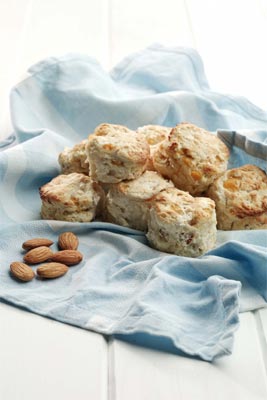Peach and almond scones

Go nuts on Australia Day
Australia Day is our big day to celebrate Australian traditions - and enjoy the influence of so many cultures and culinary delights that make Australia what it is.So many of the foods we know and love are like the people who call Australia home ... they come from all over the world. And its no different with nuts. Not only are nuts highly nutritious, great for weight management and cholesterol reduction, but tree nuts are an important part of any Australian diet, and Australia Day is the best day to celebrate this.
Grab some tree nuts for Australia Day, and youll be experiencing first hand Australians celebrated multiculturalism - see our guide below to the origins of our favourite nuts.
And while you enjoy munching down on your favourite nuts, remember that eating just a handful of assorted nuts each day can help to reduce the risk of heart disease - thats something else to celebrate.
Almonds
Almonds are traditionally grown in what we now know as Saudi Arabia, Jordan, Israel, Lebanon, Syria and Turkey. The almond tree has been cultivated since ancient times and is even mentioned in the Bible.
Australias first almond orchards appeared along Murray River in the 1950s and 60s. Theyre now grown in New South Wales, Victoria, and South Australia - and are also imported from California. These delicious nuts are an Aussie favourite loved for their distinctive taste, and also as a rich source of natural Vitamin E.
Brazil
The name gives it away. Brazil nuts are grown in the jungles of the Amazon Basin of Brazil, Peru and Bolivia. Just two Brazil nuts can provide you with your entire daily intake of the antioxidant selenium no wonder the Brazilians love to celebrate!
Cashew
Another native of Brazil, but one thats migrated around the world and is now found in Vietnam, India and Africa. Catching on to the popularity of the creamy cashew, northern Australian farmers have established experimental orchards.As a great source of magnesium, the cashew is important for strong bones.
Chestnut
Chestnuts are native to the northern hemisphere, but Australian farmers have adopted this nut as their own. Chestnuts are now grown throughout Victoria, New South Wales, southern Queensland, South Australia, Western Australia and Tasmania. Chestnuts are bursting with low Glycaemic Index (GI) carbohydrates and low in fat; everyone should make friends with a chestnut.
Hazelnut
A Turkish delight, the hazelnut is a native to modern day Turkey and Europe. While Australia imports most of its hazelnuts from Turkey and the USA, you can find the first Australian orchards in New South Wales and Victoria.
Packed full of fibre and protein for growing bodies, hazelnuts make a much better lunchbox inclusion than chips or chocolate.
Macadamia
Macadamias are part of the Australian landscape - theyve been bush tucker for thousands of years. They are grown along the coast, from the Atherton Tablelands in Queensland to Nambucca Heads in New South Wales - the macadamia enjoys life in the sun.
Jammed packed full of the good monounsaturated fats needed for wellbeing and vitality, these creamy nuts are also unbeatable for taste and crunch.
Pecan
A rich source of essential nutrients, the pecan is native to North America. Spanish explorers wrote of seeing native Americans eating pecans during the winter of 1533.
Pecans can now be found lapping up the sun in south-eastern Queensland, northern New South Wales and Western Australia. No wonder theyre so brown!
Pine nuts
Ever pined over the price of a pine nut? Pine nuts are imported from Asia and the Mediterranean hence their higher price tag. Rich in essential nutrients, only two tablespoons are needed to help keep you happy and healthy.
Pistachio
Another native of modern day Turkey and also grown in Iran and - more recently - California, the pistachio is a very popular nut. Australias nut growers have got on board and have established orchards along they Murray River - but this still isnt enough satisfy Australian demand. Pistachios are another great source of the important antioxidant, Vitamin A.
Walnuts
Another nut from the northern hemisphere, the walnut has become a much-loved Australian resident, grown in Tasmania and in the south-east corner of the mainland.
Containing Omega 3 - eating walnuts could be said to be like wearing a seat belt for your heart.
Peach and almond scones
Ingredients2¼ cups self raising flour, sifted
1½ tablespoon caster sugar
25g cold reduced salt butter, chopped
¾ cup skim milk
100g drained, chopped canned peaches in natural juice
50g raw blanched almonds, roughly chopped
1 tablespoon skim milk, extra, for brushing
Method
1. Preheat oven to 220C. Place the flour and sugar in a large bowl. Using your fingertips, mix in the butter lightly, until the mixture resembles fine breadcrumbs.
2. Add the milk, peach and almonds, mixing with a spatula until just combined.
3. Transfer the mixture to a lightly floured surface and press together into a round shape approximately 3cm high. Using a 5cm diameter biscuit cutter, cut out rounds from the dough and place on a baking tray sprinkled with a little extra flour.
4. Gather up the remaining dough, press together lightly into a round and repeat the process.
5. Brush the tops of each scone with milk. Bake for 15 minutes or until golden brown on top and hollow sounding when tapped. Serve warm or at room temperature. Makes approximately 12.
Nutrient content per serve
Energy 620kJ (150kcal), Protein 4g, Total fat 4g, Saturated fat 1g (25% of total fat), Monounsaturated fat 2g, Polyunsaturated fat 1g, Carbohydrates 23g, Fibre 2g
MORE



